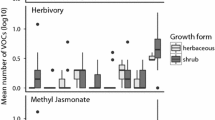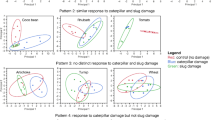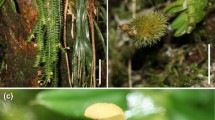Abstract
Plants produce volatile organic compounds (VOCs) in a variety of contexts that include response to abiotic and biotic stresses, attraction of pollinators and parasitoids, and repulsion of herbivores. Some of these VOCs may also exhibit diel variation in emission. In Ficus racemosa, we examined variation in VOCs released by fig syconia throughout syconium development and between day and night. Syconia are globular enclosed inflorescences that serve as developing nurseries for pollinating and parasitic fig wasps. Syconia are attacked by gallers early in their development, serviced by pollinators in mid phase, and are attractive to parasitoids in response to the development of gallers at later stages. VOC bouquets of the different development phases of the syconium were distinctive, as were their day and night VOC profiles. VOCs such as α-muurolene were characteristic of the pollen-receptive diurnal phase, and may serve to attract the diurnally-active pollinating wasps. Diel patterns of release of volatiles could not be correlated with their predicted volatility as determined by Henry’s law constants at ambient temperatures. Therefore, factors other than Henry’s law constant such as stomatal conductance or VOC synthesis must explain diel variation in VOC emission. A novel use of weighted gene co-expression network analysis (WGCNA) on the volatilome resulted in seven distinct modules of co-emitted VOCs that could be interpreted on the basis of syconium ecology. Some modules were characterized by the response of fig syconia to early galling by parasitic wasps and consisted largely of green leaf volatiles (GLVs). Other modules, that could be characterized by a combination of syconia response to oviposition and tissue feeding by larvae of herbivorous galler pollinators as well as of parasitized wasps, consisted largely of putative herbivore-induced plant volatiles (HIPVs). We demonstrated the usefulness of WGCNA analysis of the volatilome in making sense of the scents produced by the syconia at different stages and diel phases of their development.



Similar content being viewed by others
References
Balao, F., Herrera, J., Talavera, S., and Dötterl, S. 2011. Spatial and temporal patterns of floral scent emission in Dianthus inoxianus and electroantennographic responses of its hawkmoth pollinator. Phytochemistry 72:601–609.
Borges, R. M., Bessière, J.-M., and Hossaert-Mckey, M. 2008. The chemical ecology of seed dispersal in monoecious and dioecious figs. Funct. Ecol. 22:484–493.
Borges, R. M., Ranganathan, Y., Krishnan, A., Ghara, M., and Pramanik, G. 2011. When should fig fruit produce volatiles? Pattern in a ripening process. Acta Oecol 37:611–618.
Cook, J. M. and Rasplus, J.-Y. 2003. Mutualists with attitude: coevolving fig wasps and figs. Trends Ecol. Evol. 18:241–248.
Copolovici, L. O. and Niinemets, U. 2005. Temperature dependencies of Henry’s law constants and octanol/water partition coefficients for key plant volatile monoterpenoids. Chemosphere 61:1390–400.
D'Alessandro, M., Brunner, V., von Mérey, G., and Turlings, T. C. J. 2009. Strong attraction of the parasitoid Cotesia marginiventris towards minor volatile compounds of maize. J. Chem. Ecol. 35:999–1008.
de Moraes, C. M., Mescher, M. C., and Tumlinson, J. H. 2001. Caterpillar-induced nocturnal plant volatiles repel conspecific females. Nature 410:577–580.
Dearden, J. C. and Schüürmann, G. 2003. Quantitative structure–property relationships for predicting Henry’s law constant from molecular structure. Environ. Toxicol. Chem. 22:1755–1770.
Dicke, M. and Baldwin, I. T. 2010. The evolutionary context for herbivore-induced plant volatiles: beyond the ‘cry for help’. Trends Plant Sci 15:167–175.
Dicke, M., van Loon, J. J. A., and Soler, R. 2009. Chemical complexity of volatiles from plants induced by multiple attack. Nature Chem. Biol. 5:317–324.
Dudareva, N. and Pichersky, E. 2000. Biochemical and molecular genetic aspects of floral scents. Plant Physiol. 122:627–634.
Dudareva, N., Pichersky, E., and Gershenzon, J. 2004. Biochemistry of plant volatiles. Plant Physiol 135:1893–1902.
Dudareva, N., Negre, F., Nagegowda, D. A., and Orlova, I. 2006. Plant volatiles: recent advances and future perspectives. Crit. Rev. Plant Sci. 25:417–440.
Frost, C. J., Appel, H. M., Carlson, J. E., de Moraes, C. M., Mescher, M. C., and Schultz, J. C. 2007. Within-plant signalling via volatiles overcomes vascular constraints on systemic signalling and primes responses against herbivores. Ecol. Lett. 10:490–498.
Galil, J. and Eisikowitch, D. 1968. Flowering cycles and fruit types of Ficus sycomorus in Israel. New Phytol. 67:745–758.
Ghara, M. and Borges, R. M. 2010. Comparative life-history traits in a fig wasp community: implications for community structure. Ecol. Entomol. 35:139–148.
Ghara, M., Kundanati, L., and Borges, R. M. 2011. Nature’s Swiss army knives: ovipositor structure mirrors ecology in a multitrophic fig wasp community. PLoS One 6(8):e23642.
Gouinguené, S. P. and Turlings, T. C. J. 2002. The effects of abiotic factors on induced volatile emissions in corn plants. Plant Physiol. 129:1296–1307.
Grison-Pigé, L., Bessière, J.-M., and Hossaert-Mckey, M. 2002a. Specific attraction of fig-pollinating wasps: role of volatile compounds released by tropical figs. J. Chem. Ecol. 28:283–295.
Grison-Pigé, L., Hossaert-Mckey, M., Greeff, J. M., and Bessière, J.-M. 2002b. Fig volatile compounds—a first comparative study. Phytochemistry 61:61–71.
Heil, M. and Ton, J. 2008. Long-distance signaling in plant defence. Trends Plant Sci. 13:264–272.
Helsper, J. P. F. G., Davies, J. A., Bouwmeester, H. J., Krol, A. F., and van Kampen, M. H. 1998. Circadian rhythmicity in emission of volatile compounds by flowers of Rosa hybrida L. cv. Honesty. Planta 207:88–95.
Hendel-Rahmanim, K., Masci, T., Vainstein, A., and Weiss, D. 2007. Diurnal regulation of scent emission in rose flowers. Planta 226:1491–1499.
Herre, E. A., Jandér, K. C., and Machado, C. A. 2008. Evolutionary ecology of figs and their associates: recent progress and outstanding puzzles. Annu. Rev. Ecol. Evol. Syst. 39:439–458.
Hilker, M. and Meiners, T. 2011. Plants and insect eggs: How do they affect each other? Phytochemistry 72:1612–1623.
Holopainen, J. K. and Gershenzon, J. 2010. Multiple stress factors and the emission of plant VOCs. Trends Plant Sci. 15:176–184.
Hossaert-Mckey, M., Soler, C., Schatz, B., and Proffit, M. 2010. Floral scents: their roles in nursery pollination mutualisms. Chemoecology 20:75–88.
Ibrahim, M. A., Mäenpää, M., Hassinen, V., Kontunen-Soppela, S., Malec, L., Rousi, M., Pietikädnen, L., Tervahauta, A., Kärenlampi, S., Holopainen, J. K., and Oksanen, E. J. 2010. Elevation of night-time temperature increases terpenoid emissions from Betula pendula and Populus tremula. J. Exp. Bot. 61:1583–1595.
Kerdelhué, C. and Rasplus, J.-Y. 1996. Non-pollinating Afrotropical fig wasps affect the fig–pollinator mutualism in Ficus within the subgenus Sycomorus. Oikos 75:3–14.
Kesselmeier, J. and Staudt, M. 1999. Biogenic volatile organic compounds (VOC): an overview on emission, physiology and ecology. J. Atmos. Chem. 33:23–88.
Knudsen, J. T., Eriksson, R., Gershenzon, J., and Stahl, B. 2006. Diversity and distribution of floral scent. Bot. Rev. 72:1–120.
Krishnan, A., Muralidharan, S., Sharma, L., and Borges, R. M. 2010. A hitchhiker’s guide to a crowded syconium: how do fig nematodes find the right ride? Funct. Ecol. 24:741–749.
Langfelder, P. and Horvath, S. 2008. WGCNA: an R package for weighted correlation network analysis. BMC Bioinfo. 9:559.
Loreto, F. and Schnitzler, J. P. 2010. Abiotic stresses and induced BVOCs. Trends Plant Sci. 15:154–166.
Loughrin, J. N., Hamilton-Kemp, T. R., Andersen, R. A., and Hildebrand, D. F. 1990. Volatiles from flowers of Nicotiana sylvestris, N. otophora and Malus × domestica: headspace components and day/night changes in their relative concentrations. Phytochemistry 29:2473–2477.
Lucas-Barbosa, D., van Loon, J. J. A., and Dicke, M. 2011. The effects of herbivore-induced plant volatiles on interactions between plants and flower-visiting insects. Phytochemistry 72:1647–1654.
Matile, P. and Altenburger, R. 1988. Rhythms of fragrance emission in flowers. Planta 174:242–247.
Meylan, W. M. and Howard, P. H. 2005. Estimating octanol–air partition coefficients with octanol–water partition coefficients and Henry’s law constants. Chemosphere 61:640–644.
Morinaga, S. I., Kumano, Y., Ota, A., Yamaoka, R., and Sakai, S. 2009. Day–night fluctuations in floral scent and their effects on reproductive success in Lilium auratum. Popul. Ecol. 51:187–195.
Nagegowda, D. A., Rhodes, D., and Dudareva, N. 2010. The role of the methyl-erythritol-phosphate (MEP) pathway in rhythmic emission of volatiles, pp. 139–153, in C. A. Rebeiz, C. Benning, H. J. Bohnert, H. Daniell, J. K. Hoober, H. K. Lichtenthaler, A. R. Portis, and B. C. Tripathy (eds.), The Chloroplast: Basics and Application. Springer, Dordrecht.
Niinemets, U. and Reichstein, M. 2003. Controls on the emission of plant volatiles through stomata: A sensitivity analysis. J. Geophys. Res. 108(D7):4211. doi:10.1029/2002JD002626.
Niinemets, U., Loreto, F., and Reichstein, M. 2004. Physiological and physicochemical controls on foliar volatile organic compound emissions. Trends Plant Sci. 9:180–186.
Niinemets, U., Monson, R. K., Arneth, A., Ciccioli, P., Kesselmeier, J., Kuhn, U., Noe, S. M., Peñuelas, J., and Staudt, M. 2010. The leaf-level emission factor of volatile isoprenoids: caveats, model algorithms, response shapes and scaling. Biogeosciences 7:1809–1832.
Noe, S. M., Ciccioli, P., Brancaleoni, E., Loreto, F., and Niinemets, U. 2006. Emissions of monoterpenes linalool and ocimene respond differently to environmental changes due to differences in physico-chemical characteristics. Atmos. Environ. 40:4649–4662.
Owen, S. M. and Peñuelas, J. 2005. Opportunistic emissions of volatile isoprenoids. Trends Plant Sci 10:420–426.
Pichersky, E., Sharkey, T. D., and Gershenzon, J. 2006. Plant volatiles: a lack of function or a lack of knowledge? Trends Plant Sci. 11:421.
Proffit, M., Schatz, B., Borges, R. M., and Hossaert-Mckey, M. 2007. Chemical mediation and niche partitioning in non-pollinating fig-wasp communities. J. Anim. Ecol. 76:296–303.
Proffit, M., Schatz, B., Bessière, J.-M., Chen, C., Soler, C., and Hossaert-Mckey, M. 2008. Signalling receptivity: comparison of the emission of volatile compounds by figs of Ficus hispida before, during and after the phase of receptivity to pollinators. Symbiosis 45:15–24.
Proffit, M., Chen, C., Soler, C., Bessière, J.-M., Schatz, B., and Hossaert-Mckey, M. 2009. Can chemical signals, responsible for mutualistic partner encounter, promote the specific exploitation of nursery pollination mutualisms?—The case of figs and fig wasps. Entomol. Exp. Appl 131:46–57.
R Development Core Team 2010. R: A Language and Environment for Statistical Computing. R Foundation for Statistical Computing, Vienna. URL http://www.R-project.org. ISBN 3-900051-07-0.
Raguso, R. A. 2008. Wake up and smell the roses: the ecology and evolution of floral scent. Annu. Rev. Ecol. Evol. Syst. 39:549–569.
Raguso, R. A., Levin, R. A., Foose, S. E., Holmberg, M. W., and McDADE, L. A. 2003. Fragrance chemistry, nocturnal rhythms and pollination “syndromes” in Nicotiana. Phytochemistry 63:265–284.
Ranganathan, Y. and Borges, R. M. 2009. Predatory and trophobiont-tending ants respond differently to fig and fig wasp volatiles. Anim. Behav. 77:1539–1545.
Ranganathan, Y. and Borges, R. M. 2010. Reducing the babel in plant volatile communication: using the forest to see the trees. Plant Biol. 12:735–742.
Ranganathan, Y. and Borges, R. M. 2011. To transform or not to transform: that is the dilemma in the statistical analysis of plant volatiles. Plant Sign. Behav. 6:113–116.
Ranganathan, Y., Ghara, M., and Borges, R. M. 2010. Temporal associations in fig–wasp–ant interactions: diel and phenological patterns. Entomol. Exp. Appl. 137:50–61.
Rodriguez-Saona, C. R., Rodriguez-Saona, L. E., and Frost, C. J. 2009. Herbivore-induced volatiles in the perennial shrub, Vaccinium corymbosum, and their role in inter-branch signaling. J. Chem. Ecol. 35:163–175.
Sagae, M., Oyama-Okubo, N., Ando, T., Marchesi, E., and Nakayama, M. 2008. Effect of temperature on the floral scent emission and endogenous volatile profile of Petunia axillaris. Biosci. Biotech. Biochem. 72:110–115.
Snoeren, T. A. L., Mumm, R., Poelman, E. H., Yang, Y., Pichersky, E., and Dicke, M. 2010. The herbivore-induced plant volatile methyl salicylate negatively affects attraction of the parasitoid Diadegma semiclausum. J. Chem. Ecol. 36:479–489.
Steeghs, M., Bais, H. P., de Gouw, J., Goldan, P., Kuster, W., Northway, M., Fall, R., and Vivanco, J. M. 2004. Proton-transfer-reaction mass spectrometry as a new tool for real time analysis of root-secreted volatile organic compounds in Arabidopsis. Plant Physiol. 135:47–58.
Svensson, G. P., Okamoto, T., Kawakita, A., Goto, R., and Kato, M. 2010. Chemical ecology of obligate pollination mutualisms: testing the ‘private channel’ hypothesis in the Breynia–Epicephala association. New Phytol. 186:995–1004.
Theis, N. and Raguso, R. A. 2005. The effect of pollination on floral fragrance in thistles. J. Chem. Ecol. 31:2581–2600.
Tholl, D., Sohrabi, R., Huh, J.-H., and LEE, S. 2011. The biochemistry of homoterpenes – Common constituents of floral and herbivore-induced plant volatile bouquets. Phytochemistry 72:1635–1646.
Weston, D. J., Gunter, L. E., Rogers, A., and Wullschleger, S. D. 2008. Connecting genes, coexpression modules, and molecular signatures to environmental stress phenotypes in plants. BMC Systems Biol. 2:16.
Wilkinson, M. J., Owen, S. M., Possell, M., Hartwell, J., Gould, P., Hall, A., Vickers, C., and Hewitt, C. N. 2006. Circadian control of isoprene emissions from oil palm (Elaeis guineensis). Plant J. 47:960–968.
Zhang, B. and Horvath, S. 2005. A general framework for weighted gene co-expression network analysis. Stat. Appl. Genet. Mol. Biol. 4: Article 17.
Zhang, S., Wei, J., Guo, X., Liu, T-X., and Kang, L. 2010. Functional synchronization of biological rhythms in a tritrophic system. PLoS One 5(6):e11064. doi:10.1371/journal.pone.0011064.
Acknowledgments
This work was funded by the Department of Biotechnology and the Ministry of Environment and Forests, Government of India. We thank the Indo-French Centre for the Promotion of Advanced Research (IFCPAR) for supporting JMB’s travel. We thank Mahua Ghara, Lakshy Katariya, Anusha Krishnan, and Pratibha Yadav for critical comments on the data analysis.
Author information
Authors and Affiliations
Corresponding author
Electronic supplementary material
Below is the link to the electronic supplementary material.
ESM 1
(DOC 597 kb)
Rights and permissions
About this article
Cite this article
Borges, R.M., Bessière, JM. & Ranganathan, Y. Diel Variation in Fig Volatiles Across Syconium Development: Making Sense of Scents. J Chem Ecol 39, 630–642 (2013). https://doi.org/10.1007/s10886-013-0280-5
Received:
Revised:
Accepted:
Published:
Issue Date:
DOI: https://doi.org/10.1007/s10886-013-0280-5




